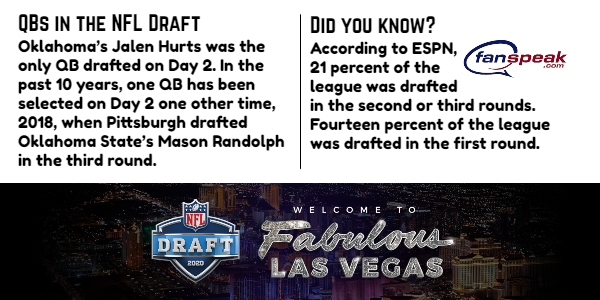Round 2 Recap: Philadelphia drafts a backup QB, Green Bay passes on receivers

Long-time ESPN draft analyst Mel Kiper put it best when he wrote that Day 2 is the day when the good teams separate themselves from the bad teams in terms of finding value and early starters.
“It’s also where the bad teams pick prospects based on traits and ceilings, and that’s how they get burned,” he said.
Who got burned? Who made smart picks? Here’s a snapshot of the round:
Surprise of the Day
Cornerback. Wide receiver. Linebacker. Philadelphia, coming off a 9-7 season, entered the draft with several pressing needs, and they were able to fill one of them with the selection of TCU receiver Jalen Reagor with pick No. 21 overall.
What wasn’t on most analysts’ needs list for Philadelphia? Quarterback. CBS Sports lists the position as the team’s ninth-most pressing need; QB wasn’t listed as a need at all by Philly Voice.
And yet, with the 53rd pick of the draft – with players like Iowa defensive lineman A.J. Epenesa, Michigan outside linebacker Josh Uche, inside linebacker Logan Wilson and LSU cornerback Kristian Fulton still on the board – Philadelphia instead drafted Oklahoma quarterback Jalen Hurts.
To be fair, the former Alabama transfer was a steady riser throughout the draft process and is generally seen as good leader who wins at every level. And, of course, Philadelphia knows the value of a good backup at QB, as Carson Wentz has missed time each of the past three seasons with injuries, including the concussion suffered last season against Seattle in the Wild Card Round, nine snaps into his first-ever postseason game.
Still, with other pressing needs, the Hurts selection was a big surprise. From Kiper:
“What makes this more of a head-scratching pick is that an edge rusher like Zack Baun or a safety like Ashtyn Davis could have helped the Eagles immediately.”
Surprise of the Day 2
The wide receiver position is considered historically deep – which should have been good news for teams like Green Bay, which needs a “Robin” to Devante Adams’ “Batman,” a good No. 2 receiver with some speed.
And the need became even more pressing when Green Bay traded a fourth-round pick to move up four spots to draft Utah State QB Jordan Love with the 26th pick of the first round.
But the one position the team had to feel pretty good about going into the 2020 season? Running back. Aaron Jones, a fifth-round pick in 2017, led the team with 1,084 yards rushing and 16 touchdowns, and Jamal Williams, drafted in the fourth round the same year Jones was drafted. Williams was second on the team in rushing with 460 yards.
Translation: The team already had two, entering-their-prime options at running back on very reasonable contracts.
So, with other pressing needs, it came as yet another surprise when the Packers selected Boston College running back A.J. Dillon with pick No. 62.
The pick was met with skepticism on social media, and not just because the team drafted a RB, as both Jones and Williams will be free agents at the end of the season. But fans and analysts alike voiced displeasure with the selection of a player that many thought would be there in rounds 3 or 4.
If the #Steelers were dead set on taking a running back, I would have loved A.J. Dillon in the 4th round. Still can't believe #Packers took him in the second. They have the worst draft so far by a landslide.
— Tommy Jaggi (@TommyJaggi) April 25, 2020
Evan, I agree 100% about A.J. Dillon – that was a real head-scratcher. What is it with the #Packers trying to limit Aaron Jones’ touches? Just trying to keep him fresh? Trying to avoid injuries? They simply won’t let him fly. #NFLDraft #NFLDraft2020
— John Frascella (Football) (@LegendSports7) April 25, 2020
The moment the Packers drafted A.J. Dillon pic.twitter.com/7bGV4YtKgT
— PFF (@PFF) April 25, 2020
Good fit: Burrow to Higgins
Cincinnati drafted a receiver to complement QB Joe Burrow in Clemson receiver Tee Higgins, who was drafted with the first pick of the second round. Many analysts thought Higgins would go in the first round despite a somewhat disappointing Pro Day, one of the last to be held before the virus restrictions.
Kerryon Johnson replacement
Kerryon Jonson, Detroit’s second-round pick in 2017, may already be on his way out, as he’s missed significant time his first two seasons with injuries. Drafting Georgia’s D’Andre Swift makes sense and presents good value, as some analysts had the junior ranked as the top RB in his class.
Dugger goes before Delpit, Winfield
The fact that Lenoir-Rhyne safety Kyle Dugger was drafted in the second round isn’t a surprise, as the small school product is one of the most athletic safeties in the draft. However, few analysts thought he’d be taken before LSU’s Grant Delpit and Minnesota’s Antoine Winfield Jr. New England drafted Dugger with 37 overall, while Delpit went to Cleveland at pick No. 44 and Winfield went to Tampa Bay the following pick.
Overall, five safeties were drafted in the second round – including Alabama’s Xavier McKinney, who was picked by the New York Giants at No. 36 and Southern Illinois’ Jeremy Chinn, who was picked by Carolina with pick No. 64, the last pick of the round – after none were taken in the first round.
Chicago picks another TE
Adam Shaheen has started just 13 games due to injuries since Chicago made the Ashland tight end the 45th pick of the 2017 draft. Still, the Bears had nine eight other tight ends on their roster.
Now the team has 10 tight ends after it drafted Notre Dame’s Cole Kmet with the 43rd pick.
The news was met with skepticism on social media.
Ryan Pace's plan to assemble a roster of 53 tight ends so no one else will have a tight end is definitely high risk/high reward.
— Will Brinson (@WillBrinson) April 24, 2020
It's currently against CDC guidelines for all the Bears TEs to be in the same room together
— Nader Issa (@NaderDIssa) April 25, 2020
Bears TE meeting Monday pic.twitter.com/rOGfxjWc0z
— Joe Byrne (@DiscoNByrno) April 25, 2020
First-round prospects fall to Second Round
A number of players who were commonly mocked in the first round fell to the second round, including:
- Penn State Edge Yetur Gross-Matos (pick No. 38 to Carolina): Gross-Matos was widely regarded as the third-best pass rusher in this draft – and that’s exactly how the draft played out, as the Penn State junior was drafted after Ohio State’s Chase Young and LSU’s K’Lavon Chaisson. But few thought YGM would fall all the way to pick 38.
- Alabama CB Trevon Diggs (pick No. 51 to Dallas): Dallas owner Jerry Jones said the team tried to trade up in the second round to take Diggs but found no takers – only to have Diggs still there at pick No. 51 overall. Some analysts had Diggs rated as the third-best CB.
- Iowa DL A.J. Epenesa (pick No. 54 to Buffalo): Epenesa saw his draft stock plummet after a poor Combine showing, but he still received high praise from opposing players. He may never develop into a 10-plus sacks per year pass rusher, but Epenesa is somewhat scheme versatile, as the junior can play the 3-tech, 5-tech and defensive end.
- Boise State OT Ezra Cleveland (pick No. 58 to Minnesota): There were rumors before the draft that Cleveland was thinking about taking the Boise State tackle Cleveland in the first round. Instead, the Browns went with Alabama’s Jedrick Wills, and Cleveland fell out of the first round altogether, finally landing with Minnesota. Cleveland was a fast-riser who many analysts predicted would slip into the late first round, so this is great value for the Vikings.
- Baylor WR Denzel Mims (pick No. 59 to N.Y. Jets): The Baylor product may have had the best Combine of any of the receivers – which is saying something for this receiving corps. And it was revealed that he played the 2018 season with a broken hand, a testament to his toughness. So for Mims to fall to the bottom of Round 2 comes as a big surprise, as Pro Football Focus called him the “most under-the-radar potential superstar of the (2020 WR) group.”
- LSU CB Kristian Fulton (pick No. 61 to Tennessee): When the draft process started, Fulton was atop many analysts’ lists as the top CB prospect in the draft. When it was all said and done, Fulton wound up being one of the last picks of the second round. Props go out to The Athletic’s Dane Brugler, who rated Fulton as the No. 60 overall prospect in his final player rankings.
Jake Rigdon (jake@sydwriting.com) covers the NFL draft for Fanspeak and the On The Clock, which is the only NFL draft simulator that allows you to customize and use your own big board while giving you control over trades.

